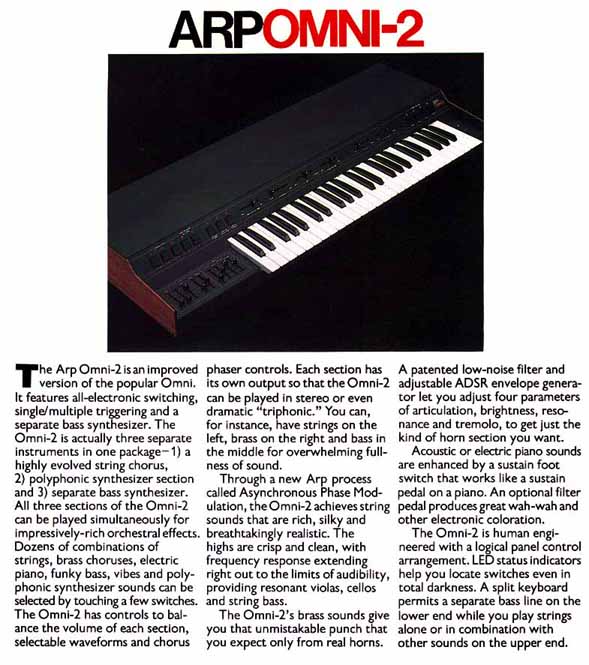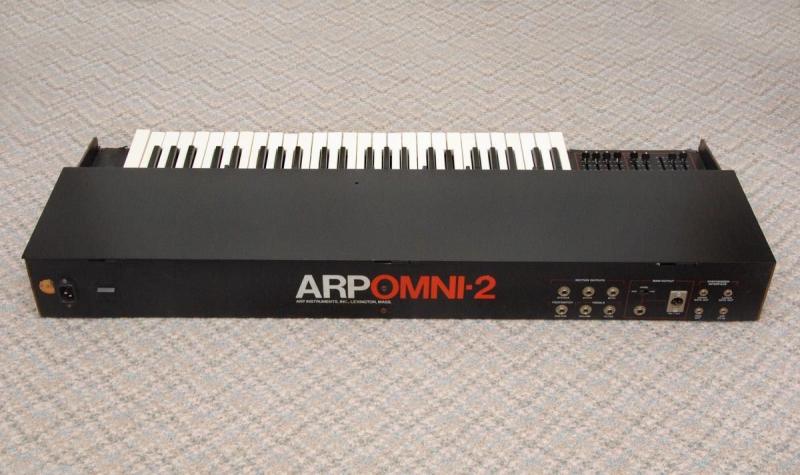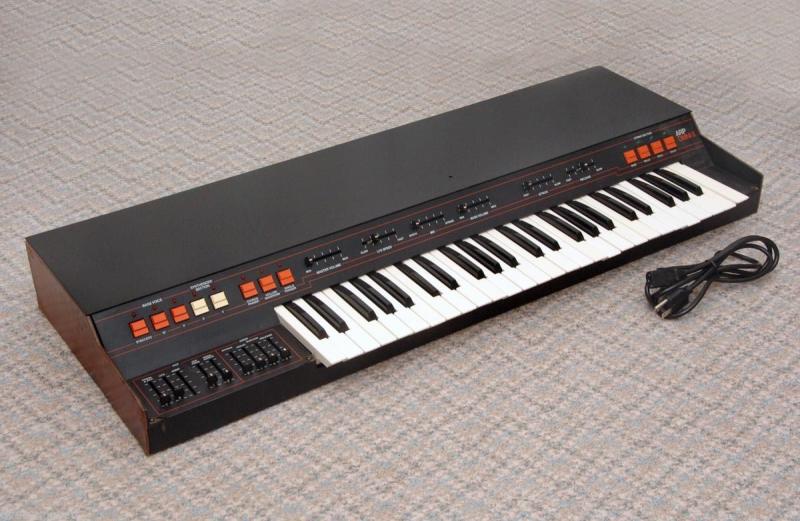Filter on ALL, SYNTH, DRUM, SAMPLER or MISC |
Total list currently 2405 items in 330 Brands |
ARP | Omni 2 |
Description | The Omni featured preset, electronically generated Orchestral ensemble String voices including polyphonic Violin and Viola sounds as well as monophonic Bass and Cello. The instrument also included a monophonic Bass Synthesizer section and a polyphonic Synthesizer section. The Synthesizer section featured a 24 dB/oct Voltage-Controlled Low Pass Filter (LPF); an ADSR envelope generator and a single waveform (triangle) Low Frequency Oscillator (LFO) were both routed to control the VCF Cutoff frequency. A Waveform Enhancement switch allowed selection of a square wave voice waveform vs. the default quasi-sawtooth waveform. The ARP Omni had a unique logo that was painted on to the back face of the unit. The String and Synthesizer sections of the 49-note Omni utilized the Mostek MK50240 Top Octave generator IC along with divide-down circuitry; as a result, these sections were fully polyphonic, as opposed to subsequent polyphonic synthesizers such as the Sequential Circuits Prophet-5 and Yamaha CS-80 which featured dynamically allocated, limited polyphony of 5- and 8-voices respectively. But then, these units featured a far more comprehensive and complex synthesis architecture. The three sections of the Omni - Strings, Synthesizer, and Bass - were all simultaneously available and mixable; the String and Synthesizer sections featured separate audio outputs on the rear panel of the unit which allowed separate amplification and signal processing of these sections for stereo effects. The Omni was single-oscillator in nature; normally, the String section alone was processed through the on board, patented ARP 3-voice Chorus Phaser circuit, producing the lush, moving sound the instrument is most known for. However, the Synthesizer section was processed through this circuit when a front panel "Chorus Phaser" switch was activated, simultaneously summing the String and Synthesizer section outputs and slowing the Chorus speed. ARP later released the Omni Mk 2. It was basically the same machine as its predecessor, except for a few minor enhancements and a cosmetic Orange & Black color-scheme upgrade. And it did have a much more advanced triggering system for the VCF and VCA for more expressive results. |
| Brand | ARP |
| Model | Omni 2 |
| Device | Synth |
| Type | Keys |
| Engine Type | Analog |
| Engine | VCO Preset |
| Voices (max) | 49 |
| Oscillators | 4 |
| LFO | One variable speed LFO for string section with Sine wave shape |
| Engine Detailed | 4 preset sounds: Violin (polyphonic), Viola (polyphonic), Cello (monophonic), Bass (monophonic) |
| Filter (VCF) | Model 4075 4-pole, 24db lowpass with its own ADSR & Omni 2 added LFO control to VC |
| Envelope (VCA) | Omni 1: AR only; Omni 2: ADSR |
| Memory | Preset |
| Keys | 49 |
| Key type | Keys |
| Velocity | No |
| Aftertouch | No |
| CV-gate | CV/GATE |
| Produced: | 1975 - 1981 |
| Legend: | Obvious | Y: Yes, N: No, N/A: Not Applicable | |
| VCO | Voltage Controlled Oscillator | DCO | Digital Controlled Oscillator |
| LFO | Low Frequency Oscillator | Sub | Sub Oscillator |
| VCF | Voltage Controlled Filter | VCA | Voltage Controlled Amplifier |
| Velocity | As with a piano, the harder you hit a key, the louder the sound, unlike most organs which always produce the same loudness no matter how hard you hit a key. | Aftertouch | Pressing a key after you activated it. Channel Aftertouch, no matter which key, it will send a Channel message. Poly Aftertouch, sends the pressure per key instead of the whole channel. |
| Values for OSC, LFO, Filter, Envelope are per voice unless stated otherwise. | |||





